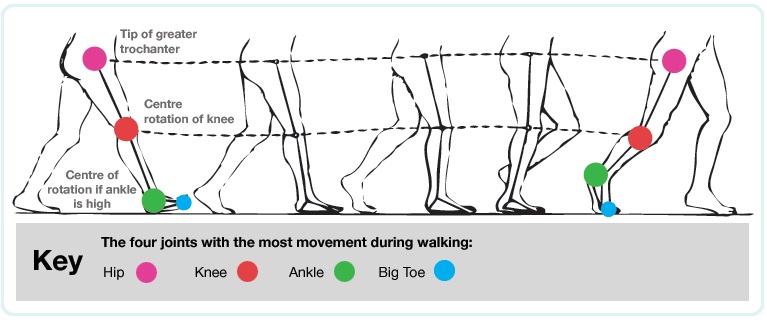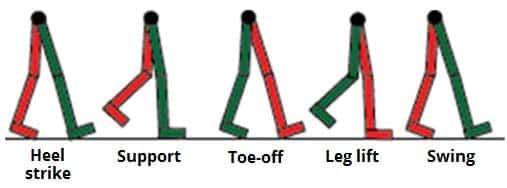Describe the Joints and Movements Involved in Walking
The point at which two or more bones meet is called a joint or articulation. Though complex if you break down each of these movements joint by joint the mechanics of walking become clear.

Biomechanics Of Walking Gait Footeducation Biomechanics Muscular System Anatomy Walking
The muscles most involved in walking are the quadriceps.

. Chewing food 192. Start studying Joints and Muscles for movement. I need to identify and describe the movement of joints used in walking and throwing a dart.
Frontal plane divides the body into anterior and posterior portions. This movement pattern is usually involuntary. Lets break down a basic walk step.
An example of this movement would be lifting your arms and legs out to the side while doing a. Refers to movement where the angle between two bones increases. Circular motion of the arm thigh hand thumb or finger that is produced by the sequential combination of flexion abduction extension and adduction.
Crossing your legs while sitting 5. Name the joint movements involved in walking. Gluteus maximus Gluteus medius posterior fibers Semitendiunosus Semimembranosus Biceps femoris long.
Turning a doorknob 4. The pelvis fluctuates in two planes vertical and lateral. According to May Q.
Liu and colleagues in an article for the Journal. ContentsExtensionFlexionAbductionAdductionExternal Rotation Lateral RotationInternal Rotation Medial Rotation. This occurs when the angle of a joint decreases.
Walks are very complex. For example the elbow flexes. Identify each one and where they are located.
Refers to movement where the angle between two bones decreases. The primary muscles that facilitate walking include the quadriceps and hamstrings in the thighs the calf muscles in the lower legs and the hip adductors. There are two ways to classify joints.
To help describe movement we use the terminology of planes. The different types of movement that are permitted at each joint are described below. Movement in the coronal plane that moves a limb medially toward or across the midline of the body.
The gluteal and the abdominal muscles also play a significant role in forward motion. It follows a pine cone shaped path of movement. For example the elbow flexes when performing a biceps curl.
Learn vocabulary terms and more with flashcards games and other study tools. When you turn a doorknob there are two movements involved in the elbow. Short-Answer Questions Describe the joints and movements involved in the following tasks.
Flexion bending a joint. Examples are the movement of the humerus at the shoulder and the femur at the hip. Pronation and Supination are movements of the forearm.
I have done a lot of research and reading but this unit is going over my head. Flexion is commonly known as bending. The Functional Anatomy of Walking.
However when something is off it creates a cacophony jarring on the senses and in the case of the walker probably jarring on. Circumduction is a combination of abduction and adduction flexionextension and rotation and occurs at multiaxial joints. That is it involves placing the palms into the prone face-down position like looking at the backs of the hands.
The body in a flowing gait is like a well-honed orchestra each section communicates with the other rising and falling in harmony with ease and grace a pleasure to the senses. The Muscles Involved With Walking. ANATOMY OF A WALK.
What types of synovial joints are involved in sitting down at a table. Movement of the lower limbs during walking must swing the center of gravity the pelvis. Is the movement of the hands to turn the palms posteriorly.
Figure 952 Movements of the Body Part 2. Shaking your head no 6. The primary muscles involved in walking are of the lower leg and the thigh and knee.
On the basis of. Short-Answer Questions Describe the joints and movements involved in the following tasks. Crossing your legs while sitting 5.
Hip - extension flexion Knee - flexion extension Foot - dorsiflexion plantar flexion. This occurs when the angle of a joint decreases. Ball and socket - hips Hinge - knee.
Turning a doorknob 4. Throwing a ball 3. Throwing a ball а 3.
Muscles of thigh and knee Vastus lateralis medialis obliques and rectus femoris. Hinge joints allow flexion and extension only. There are three planes of movement in the human body the frontal and sagittal planes are shown in Figure 21a.
Short-Answer Questions Describe the joints and movements involved in the following tasks. Some of the key joint actions that you should know are detailed in the following tables. Joints are responsible for movement eg the movement of limbs and stability egthe stability found in the bones of the skull.
Turning the forearm from the supine. Any help is much appreciated. In the vertical plane the pelvis would oscillate depending on the leg elevating and laterally at bows to the leading leg.
Describe where it occurs. Flexion bending a joint. Short-Answer Questions Describe the joints and movements involved in the following tasks.
Not only do the feet have to move across the ground but the hips spine arms shoulders and head all move in sync to maintain balance in the system. As-well-as how certain muscles help with the process. Extension is otherwise known as straightening.
Shaking your head no 6. Muscles involved in walking are Muscles of lower leg - Soleus gastrocnemius tibialis anterior posterior and peroneals. Is the movement with the arms extended to the sides of the trunk.
Straightening the hip joint by moving the thigh andor torso posteriorly backward. Terms in this set 5 Joints used for walking up stairs. Hip- extensionflexion Knee- extension.
G Supination of the forearm turns the hand to the palm forward position in which the radius and ulna are parallel while forearm pronation turns the hand to the palm backward position in which the radius crosses over the ulna to form an X h Dorsiflexion of the foot at the ankle joint moves the top of the foot toward the leg while. There are plenty of them that are used to produce the action of walking but mainly the muscles of the lower extremities do.

Walking Disorders How Nerve And Joint Injuries Change Gait Disorders Peripheral Nervous System Nerve Damage

The Mechanics Of Walking American Bone Health

Walking And Gaits Stages Teachmeanatomy

The Many Benefits Of Walking And Jogging In Case You Re Still Looking For Reasons Infographic Infographic Health Jogging Benefits Benefits Of Walking
No comments for "Describe the Joints and Movements Involved in Walking"
Post a Comment